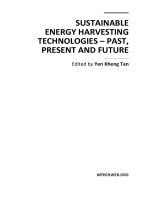Climate Management - Solving the Problem Part 1 pot
Bạn đang xem bản rút gọn của tài liệu. Xem và tải ngay bản đầy đủ của tài liệu tại đây (2.2 MB, 29 trang )
Climate
Management
Gl bal
WarminG
Gl bal
Warmin
Gl bal
Warmin
Julie Kerr Casper, Ph.D.
Climate
Management
Solving the Problem
Gl bal
WarminG
Gl bal
Warmin
Gl bal
Warmin
CLIMATE MANAGEMENT: Solving the Problem
Copyright © 2010 by Julie Kerr Casper, Ph.D.
All rights reserved. No part of this book may be reproduced or utilized in any form or by any means,
electronic or mechanical, including photocopying, recording, or by any information storage or
retrieval systems, without permission in writing from the publisher. For information contact:
Facts On File, Inc.
An imprint of Infobase Publishing
132 West 31st Street
New York NY 10001
Library of Congress Cataloging-in-Publication Data
Casper, Julie Kerr.
Climate management : solving the problem / Julie Kerr Casper.
p. cm.—(Global warming)
Includes bibliographical references and index.
ISBN 978-0-8160-7266-8 (hardcover)
ISBN 978-1-4381-2742-2 (e-book)
1. Climatology—Popular works. 2. Global warming—Popular works. I. Title.
QC863.4.C36 2009
363.738'74—dc22 2009021254
Facts On File books are available at special discounts when purchased in bulk quantities for
businesses, associations, institutions, or sales promotions. Please call our Special Sales Department
in New York at (212) 967-8800 or (800) 322-8755.
You can nd Facts On File on the World Wide Web at tsonle.com
Text design by Erik Lindstrom
Illustrations by Dale Williams
Photo research by the author
Composition by Hermitage Publishing Services
Cover printed by Bang Printing, Brainerd, MN
Book printed and bound by Bang Printing, Brainerd, MN
Date printed: April 2010
Printed in the United States of America
10 9 8 7 6 5 4 3 2 1
is book is printed on acid-free paper and contains 30 percent postconsumer recycled content.
Contents
Preface viii
Acknowledgments xii
Introduction xiv
1 e Beginning of Global Warming Management 1
e Human Link 2
e United Nations Framework Convention on
Climate Change and the Kyoto Protocol 4
e Impacts of Warming in the United States and Canada 5
e U.S. Response and International Reactions 14
e Intergovernmental Panel on Climate Change 20
IPCC Reports 25
2 e U.S. Political Arena 32
e Current Political Climate 32
President Obama and His Outlook on Global Warming 36
National Security and Terrorism 40
Current Legislation 44
3 Cap and Trade and Other Mitigation Strategies 55
Cap and Trade 55
State Mitigation Projects 62
Economics of Mitigation 68
4 e International Political Arena 72
An Expert’s Warning 72
e Evolution of International Cooperation 75
e Role of International Organizations 78
e Progress of Individual Countries 84
5 Global Warming, Human Psychology, and the Media 92
Human Psychology and Cultural Values 92
e Power of the Media 95
Keeping a Journalistic Balance 97
Scientists’ Mindsets and Data Change 100
6 e Stand on the Debate 103
Understanding Modern Climate 104
e Far Right—Skeptics of Global Warming 109
e Middle Ground 115
e Far Le—Believers in Global Warming 116
7 Green Energy and Global Warming Research 122
e Environmental Benets of Green Energy 122
Solar Energy 130
New Ways to Store Solar Energy 137
Geothermal Energy 139
Wind Energy 142
Hydropower 146
Energy from Biomass 148
Biofuel Crop Bans in Europe 151
Ocean Energy 152
Global Warming Research 155
8 Climate Modeling 159
e Modeling Challenge—A Brief History 160
Fundamentals of Climate Modeling 162
Watching Earth’s Climate Change in the Classroom 171
Modeling Uncertainties and Challenges 172
9 Practical Solutions at Work—Getting Everyone Involved 182
Taking Action 183
Practical Solutions to Global Warming 184
e 2007 Nobel Peace Prize 185
Suggested Solutions at Are Not So Practical 193
Prioritizing Adaptation Strategies 198
Simple Activities Everyone Can Do 199
10 e Future: What Lies Ahead 210
A Look toward the Future 211
Winners and Losers 216
New Technologies 219
e Final Choice 222
Appendixes 223
Chronology 233
Glossary 239
Further Resources 247
Index 255
viii
We do not inherit the Earth from our ancestors—
we borrow it from our children.
T
his ancient Native American proverb and what it implies resonates
today as it has become increasingly obvious that people’s actions
and interactions with the environment aect not only living condi-
tions now, but also those of many generations to follow. Humans must
address the eect they have on the Earth’s climate and how their choices
today will have an impact on future generations.
Many years ago, Mark Twain joked that “Everyone talks about the
weather, but no one does anything about it.” at is not true anymore.
Humans are changing the world’s climate and with it the local, regional,
and global weather. Scientists tell us that “climate is what we expect,
and weather is what we get.” Climate change occurs when that average
weather shis over the long term in a specic location, a region, or the
entire planet.
Global warming and climate change are urgent topics. ey are
discussed on the news, in conversations, and are even the subjects of
horror movies. How much is fact? What does global warming mean to
individuals? What should it mean?
e readers of this multivolume set—most of whom are today’s
middle and high school students—will be tomorrow’s leaders and sci-
entists. Global warming and its threats are real. As scientists unlock the
mysteries of the past and analyze today’s activities, they warn that future
PrefaCe
ix
Preface
generations may be in jeopardy. ere is now overwhelming evidence
that human activities are changing the world’s climate. For thousands of
years, the Earth’s atmosphere has changed very little; but today, there are
problems in keeping the balance. Greenhouse gases are being added to
the atmosphere at an alarming rate. Since the Industrial Revolution (late
18th, early 19th centuries), human activities from transportation, agricul-
ture, fossil fuels, waste disposal and treatment, deforestation, power sta-
tions, land use, biomass burning, and industrial processes, among other
things, have added to the concentrations of greenhouse gases.
ese activities are changing the atmosphere more rapidly than
humans have ever experienced before. Some people think that warm-
ing the Earth’s atmosphere by a few degrees is harmless and could have
no eect on them; but global warming is more than just a warming—or
cooling—trend. Global warming could have far-reaching and unpredict-
able environmental, social, and economic consequences. e following
demonstrates what a few degrees’ change in the temperature can do.
e Earth experienced an ice age 13,000 years ago. Global tempera-
tures then warmed up 8.3°F (5°C) and melted the vast ice sheets that cov-
ered much of the North American continent. Scientists today predict that
average temperatures could rise 11.7°F (7°C) during this century alone.
What will happen to the remaining glaciers and ice caps?
If the temperatures rise as leading scientists have predicted, less fresh-
water will be available—and already one-third of the world’s population
(about 2 billion people) suer from a shortage of water. Lack of water will
keep farmers from growing food. It will also permanently destroy sensitive
sh and wildlife habitat. As the ocean levels rise, coastal lands and islands
will be ooded and destroyed. Heat waves could kill tens of thousands
of people. With warmer temperatures, outbreaks of diseases will spread
and intensify. Plant pollen mold spores in the air will increase, aecting
those with allergies. An increase in severe weather could result in hur-
ricanes similar or even stronger than Katrina in 2005, which destroyed
large areas of the southeastern United States.
Higher temperatures will cause other areas to dry out and become
tinder for larger and more devastating wildres that threaten forests,
wildlife, and homes. If drought destroys the rain forests, the Earth’s
x
Climate management
delicate oxygen and carbon balances will be harmed, aecting the water,
air, vegetation, and all life.
Although the United States has been one of the largest contribu-
tors to global warming, it ranks far below countries and regions—such
as Canada, Australia, and western Europe—in taking steps to x the
damage that has been done. Global Warming is a multivolume set that
explores the concept that each person is a member of a global family
who shares responsibility for xing this problem. In fact, the only way
to x it is to work together toward a common goal. is seven-volume
set covers all of the important climatic issues that need to be addressed
in order to understand the problem, allowing the reader to build a solid
foundation of knowledge and to use the information to help solve the
critical issues in eective ways. e set includes the following volumes:
Climate Systems
Global Warming Trends
Global Warming Cycles
Changing Ecosystems
Greenhouse Gases
Fossil Fuels and Pollution
Climate Management
ese volumes explore a multitude of topics—how climates change,
learning from past ice ages, natural factors that trigger global warming
on Earth, whether the Earth can expect another ice age in the future,
how the Earth’s climate is changing now, emergency preparedness
in severe weather, projections for the future, and why climate aects
everything people do from growing food, to heating homes, to using
the Earth’s natural resources, to new scientic discoveries. ey look
at the impact that rising sea levels will have on islands and other areas
worldwide, how individual ecosystems will be aected, what humans
will lose if rain forests are destroyed, how industrialization and pollu-
tion puts peoples’ lives at risk, and the benets of developing environ-
mentally friendly energy resources.
e set also examines the exciting technology of computer model-
ing and how it has unlocked mysteries about past climate change and
global warming and how it can predict the local, regional, and global
xi
Preface
climates of the future—the very things leaders of tomorrow need to
know today.
We will know only what we are taught;
We will be taught only what others deem is important to know;
And we will learn to value that which is important.
—Native American proverb
xii
G
lobal warming may very well be one of the most important issues
you will have to make a decision on in your lifetime. e deci-
sions you make on energy sources and daily conservation practices will
determine not only the quality of your life, but also the lives of your
descendants.
I cannot stress enough how important it is to gain a good under-
standing of global warming: what it is, why it is happening, how it can
be slowed down, why everybody is contributing to the problem, and
why everybody needs to be an active part of the solution.
I would sincerely like to thank several of the federal government
agencies that research, educate, and actively take part in dealing with
the global warming issue—in particular, the National Aeronautics and
Space Administration (NASA), the National Oceanic and Atmospheric
Administration (NOAA), the Environmental Protection Agency (EPA),
and the U.S. Geological Survey (USGS) for providing an abundance of
resources and outreach programs on this important subject. I give spe-
cial thanks to James E. Hansen, Al Gore, and Arnold Schwarzenegger
for their diligent eorts toward bringing the global warming issue so
powerfully to the public’s attention. I would also like to acknowledge
and give thanks to the many wonderful universities across the United
States, in England, Canada, and Australia, as well as private organiza-
tions, such as the World Wildlife Fund, that diligently strive to educate
others and help toward nding a solution to this very real problem.
aCknowledgments
xiii
acknowledgments
I want to give a huge thanks to my agent, Jodie Rhodes, for her assis-
tance, guidance, and eorts; Frank K. Darmstadt, executive editor, for
all his hard work, dedication, support, and helpful advice and attention
to detail; Alexandra Lo Re, assistant editor; and the production depart-
ment for their assistance and the outstanding quality of their work.
xiv
W
hether people argue that global warming is caused by natu-
ral phenomena or by humans—or both—it is one of the most
controversial topics in the scientic world today. Scientists have many
theories about global warming and because there are so many factors
involved, it is dicult to pinpoint exactly what causes it and what is to
be done. Earth’s climate is extremely complicated, and climatologists are
conducting daily research in order to improve their understanding of
all the interrelated components.
Each year, about 7 billion tons (6.4 metric tons) of carbon is released
into the atmosphere. Studies show that concentrations of carbon diox-
ide have increased by about one-third since 1900. During this same
time period, experts say the Earth has warmed rapidly. Many scientists
believe this means that humans are contributing signicantly to global
warming. Even scientists who are skeptical about global warming rec-
ognize that there is much more carbon dioxide in the atmosphere than
ever before.
Many natural events can cause the Earth’s climate to change, such
as shiing ocean currents, changes in the amount of solar energy that
reaches the Earth, and the eruption of volcanoes. Human-induced causes
are also critical, such as burning fossil fuels and polluting the atmo-
sphere. Today, there is a wealth of evidence supporting global warming:
measured increases in average temperatures; changing rainfall patterns;
rising sea levels; glaciers thinning and retreating; coral reefs dying as
IntroduCtIon
xv
Introduction
oceans become warmer; more frequent droughts in Africa and Asia;
permafrost melting in the Arctic; lakes and rivers that freeze during
the winter thawing earlier; plants and animals shiing habitat ranges
toward the polar regions and to higher altitudes on mountains; and dis-
rupted migration patterns for wildlife, such as polar bears, whales, and
the monarch buttery.
One of scientists’ biggest concerns about global warming is that the
real danger is unknown. Because climate is such a complicated system,
there are still a lot of areas in climatology that are not well understood.
As computer models become more sophisticated and instruments are
developed that can identify and monitor specic portions of the atmo-
sphere, experts will have a better idea on how best to manage the human
impact on climate. One thing is certain—human behavior has an enor-
mous impact on global warming.
What is desperately needed at this point is for countries to begin
working together to solve these issues. Not just a handful of countries
can x climate change—it is a global problem. Developed countries such
as the United States or Great Britain are more nancially able to make
changes, however, a way must be found to bring all nations of the world
into the discussion and solution of climate change. Climate Management
focuses on changing human behavior as the rst step toward xing the
problem to keep the world from suering the disastrous eects of cli-
mate change. e book discusses the role of the United Nations in the
eort to manage global warming and explores human psychology and
how cultural values, politics, and news dissemination can aect people’s
opinions, thereby driving public response. e book also informs the
reader how global warming aects national security and why its pro-
gression is a very real threat to everyone’s future.
Climate Management outlines the contributions and successes of the
IPCC and the Kyoto Protocol to the worldwide eort to control global
warming and explains why a global push to combat this problem is the
only way any solution will be found. e book also presents various
conservation programs that have been developed by individual coun-
tries, international committees, private organizations, and individuals.
xvi
Climate management
It looks at what is working and what is not, and it addresses energy
reduction practices, energy eciency, and environmental challenges,
practical ways to reduce energy consumption, home modications, and
future energy demand. It then outlines why public education is so criti-
cal and how it plays an enormous part in the future of the problem.
Climate Management looks at cap-and-trade policies and other
forms of mitigation that have been proposed by governments world-
wide in order to get a handle on this runaway problem. One mitigation
technique discussed in detail is the use of renewable energy resources,
and why solar, wind, geothermal, hydroelectric, and other sources of
clean, renewable energy are going to play a critical role in the future.
e volume takes the reader into the exciting world of high-tech
computer modeling and the newest advances in analyzing weather and
climate via mathematical models to predict future global warming and
the impacts of greenhouse gases. It explores the fascinating science of
weather prediction, advanced climate modeling and computer simula-
tion of the atmosphere and ocean, and remote sensing and satellite data
and their roles in long-term monitoring and change detection. It also
looks at the latest scientic discoveries, where continued research needs
to occur, and technologies waiting on the horizon.
Climate Management expands on government and public involve-
ment, presents readers with numerous activities that everyone can do
to combat the problem, and explains how concerned environmentalists
can get involved today. Finally, it takes a look into the future and what
lies ahead in this warming world.
1
1
The Beginning of
Global Warming
Management
O
ver the past several decades, technology has progressed to the
point where humans can make use of the Earth’s natural resources
to make their lives much more comfortable and enjoy a higher stan-
dard of living. However, this has come with a heavy price. As pop-
ulations have continued to grow, human consumption of natural
resources has continued to accelerate, causing severe global environ-
mental problems.
Increasing demands have stressed limited existing resources and
contributed to global warming. e very health of the ecosystems that
humans depend on for survival is becoming threatened and endan-
gered. In addition, unsustainable consumption of fossil fuels and other
resources such as water has not only contributed to global warming,
but has also stressed developing countries, aected health, caused eco-
nomic tension, and threatened national security.
2
Climate management
is chapter looks at the beginnings of global warming manage-
ment—the stage when both the scientic and environmental com-
munities’ outcry got to the point that ocial action was nally taken
to combat the Earth’s rising temperatures. It discusses the human
link to the problem and outlines the role of the United Nations (UN),
the Kyoto Protocol, and various political responses. Finally, it reviews
the Intergovernmental Panel on Climate Change (IPCC) and its
importance.
The human Link
Only 20 percent of the Earth’s population lives in industrialized
countries, yet they consume nearly 70 percent of the Earth’s natural
resources. e United States is home to less than 5 percent of the Earth’s
population, but consumes about 25 percent of its natural resources. e
ecological “footprint,” or signature, that a society leaves on the Earth
is signicant; not only for the population inhabiting the Earth today,
but for all generations to come. Ecological footprints are visible at all
scales. Locally, they are visible as populations’ daily activities aect the
air, water, and land quality of cities and states. It is easy to observe pol-
luting industrial processes, mining processes, and trac congestion. It
is more dicult to see how every person’s buying or driving decisions
aect the entire world.
Each time someone buys a car that is energy inecient, chooses not
to use sustainable, renewable energy or not to recycle and reduce their
waste, does not purchase locally to cut down on transportation costs
or not limit the amount of CO
2
emissions released to the atmosphere
because of their activities, they aect the world. Individual choices add
up. Each person has the power to make a dierence by reducing their
personal consumption, buying green products, and using clean, ecient
technology. Every individual can be accountable in working toward x-
ing the problem of global warming.
In order to do this, informed decisions need to be made. e prob-
lem involves every person on Earth. Business and government actions
are also important. Business can take the lead by purchasing recycled
supplies (such as paper), investing in ENERGY STAR equipment
(Xerox machines, FAX machines, computers, etc.), remodeling to con-
3
The Beginning of Global Warming Management
serve energy, using uorescent lighting, shutting o lights in unused
rooms, using sinks with automatic water shuto, monitoring heating
and air-conditioning, and oering telecommuting working arrange-
ments (working from home).
An article that appeared in ScienceDaily on February 5, 2007, dis-
cussed the IPCC’s Fourth Assessment Report (AR4) that attributes
human-derived greenhouse gases as an overwhelmingly signicant con-
tributor to observed global warming. According to Gabriele Hegerl,
associate research professor at Duke’s Nicholas School of the Environ-
ment and Earth Sciences, “We are now seeing, not merely predicting,
eects of greenhouse warming on a scale and in ways that were not
observable before. When you look at the changes in temperature, cir-
culation, ocean warming, Arctic sea ice reduction, and glacial retreat
together, it paints a much clearer picture that external drivers, particu-
larly greenhouse gases, are playing a key role. As a result, we can be
much more condent that 20th-century climate changes were not just
linked to natural variability.
“We’ve studied improved observations from land, sea, and space, as
well as better temperature reconstructions covering the last 1,000 years.
By comparing observations against modeled projections, scientists are
gaining a better sense of which external climate inuences have been
important.
“Understanding the observations is what this is really all about. For
instance, looking at the patterns of change in 20th-century tempera-
tures, we can now distinguish between changes caused by greenhouse
gases, man-made aerosols, variability in solar radiation, and major vol-
canic eruptions.
“We now are beginning to understand that changes occur at least
partly in response to anthropogenic inuences on climate,” Hegerl
concluded.
According to a New York Times article on January 14, 2007, there
is already enough overwhelming evidence available today to leave no
doubt that human interaction is a large piece of the global warming
puzzle. While it is dicult to blame global warming for a specic hur-
ricane or ood or drought or forest re, it is the collective evidence that
points to the distinct anthropogenic inuence.
4
Climate management
Several trends have been identied, as follows:
e global average minimum nighttime temperature has
risen. Scientists at the National Aeronautics and Space
Administration (NASA) believe this is unrelated to the Sun
and is linked to the greenhouse gases that hold in heat radi-
ating from the Earth’s surface long aer the Sun has gone
down.
e stratosphere (a portion of the upper atmosphere) has
cooled, which happens when excessive amounts of heat are
trapped closer to the Earth’s surface. If the change was due
to a variation in the Sun’s output, both atmospheric layers
would change simultaneously.
ere has been a universal warming trend over both the
land and the oceans. is removes urbanization as a sole
cause.
Improved climate models repeatedly conrm the anthropo-
genic addition of greenhouse gases to the atmosphere.
THE UNITED NATIONS FRAMEWORK CONVENTION
ON CLIMATE CHANGE AND THE KYOTO PROTOCOL
e international policy response to climate change began with the
negotiation of the United Nations Framework Convention on Climate
Change (UNFCCC), which eventually led the way for the creation and
establishment of the Kyoto Protocol—the legal framework for global
action to cut greenhouse gas (GHG) emissions.
The UNFCCC
e UNFCCC is an international environmental treaty that was pro-
duced at the United Nations Conference on Environment and Devel-
opment (UNCED). e UNCED is also known as the Earth Summit,
the Rio Summit, and Eco ’92. It was held in Rio de Janeiro from June
3–14, 1992. e purpose of the treaty was to stabilize greenhouse gas
concentrations in the atmosphere in order to prevent global warming.
As it was set up, the treaty was nonbinding since it did not set any man-
datory limits on greenhouse gas emissions for individual countries.
•
•
•
•
5
The Beginning of Global Warming Management
THE IMPACTS OF WARMING
ON THE UNITED STATES
AND CANADA
According to the IPCC, the United States and Canada will not escape the
eects of global warming. In their report issued on April 6, 2007, they con-
rm that global warming is already aecting the environment. When the
atmospheric temperature rises a little higher—even a few degrees—what
may merely be uncomfortable heat now may become dangerous to the
point of causing death. This will be felt all the way from Florida and Texas
to Alaska and Canada’s Northwest Territories.
According to Achim Steiner, executive director of the United Nations
Environment Programme (UNEP) “Canada and the United States are,
despite being strong economies with the nancial power to cope, facing
many of the same impacts that are projected for the rest of the world.”
Chicago and Los Angeles will likely face increasing heat waves. Chicago
is expected to see a 25 percent increase in heat waves later this century
and dangerously hot days in Los Angeles are projected to increase from
a dozen per year to between 44 and 100. North American wood and tim-
ber production could suer huge economic losses of $1 to $2 billion a
year during the 21st century if climate change triggers diseases, insect
infestations, and wildres. Groundwater aquifers in Texas, South Dakota,
Nebraska, Wyoming, Colorado, Kansas, Oklahoma, and New Mexico could
see a lessening of recharge of 20 to 40 percent, causing problems for farm-
ers and population centers.
Winter recreation in eastern North America may disappear by the
2050s, striking a hard blow to the recreation industry. Costs to replenish
Florida’s beaches with new sand after sea-level rise may cost upward of
$9 billion.
The IPCC also cautions that severe storm surges could hit Boston and
New York City. Cities that rely on melting snow for water, such as those
in the drainage basins of the Rocky Mountains and Sierra Nevada, may
experience serious water shortages. In particular, increased tension over
water availability will result. As rainfall patterns shift, temperatures rise,
and glaciers melt around the world, the demand for dwindling supplies of
water will likely increase tensions across cultural and political borders.
The IPCC predicts that as temperatures rise summer ows will
drastically reduce, leaving huge areas without adequate water. As an
example, they report that “A warming of a few degrees by the 2040s is
(continues)
6
Climate management
What the treaty did include was provisions for updates (called proto-
cols) that would set mandatory emission limits. e principal update
is the Kyoto Protocol, the international agreement that sets binding
targets for 37 industrialized countries and the European community
for reducing GHGs.
e UNFCCC was opened for signature on May 9, 1992, and entered
into force on March 21, 1994. Its principal objective was “to achieve sta-
bilization of greenhouse gas concentrations in the atmosphere at a low
enough level to prevent dangerous anthropogenic interference with the
climate system.”
One of the UNFCCC’s rst major achievements was that it set into
place a “National Greenhouse Gas Inventory,” which serves as a tabula-
tion of GHG emissions and removals. All countries that signed the treaty
must submit a greenhouse gas record on a regular basis. Nations that
signed the treaty are divided into three groups: (1) Annex I countries,
which are the industrialized countries; (2) Annex II countries, which
are the developed countries that pay for costs of developing countries;
and (3) developing countries. e UNFCCC has been ratied by the
United States, Canada, France, Germany, the United Kingdom, Aus-
likely to sharply reduce summer ows. As population increases, by then
Portland, Oregon, alone will need over 918 million cubic feet (26 million
cubic meters) of additional water due to climate change and population
growth. The Columbia River’s water supply is expected to be much lower,
however: about 177 million cubic feet (5 million cubic meters) lower.”
The IPCC also warns of storm surges and high tides and predicts that
by the 2090s, a one in 500-year ood could be a one in 50-year event in
New York City, meaning New York could face serious damage sooner and
more frequently.
(continued)
7
The Beginning of Global Warming Management
tralia, Austria, Denmark, Finland, and virtually the entire international
community (see Appendix).
e Annex I countries agree to reduce their GHG emissions to levels
that are below their 1990 levels. If industries exceed their allotted limits
they must buy emission allowances or oset their excesses through a
UN Headquarters in New York City (Nature’s Images)
8
Climate management
mechanism that is agreed upon by the UNFCCC. e Annex II coun-
tries (which are a subgroup of the Annex I countries) also participate
as OECD (Organisation for Economic Co-operation and Development)
members. e developing countries are not expected to cut back on their
carbon emissions unless developed countries provide them with the nec-
essary funding and technology to accomplish it. Developing countries
can become Annex I countries once they have become developed.
ere have been opponents to the treaty who believe that not
requiring developing countries to control their emissions is not fair.
ey feel that all countries should have to reduce emissions equally.
Some developing countries have said they cannot aord the costs of
compliance. Other countries have countered that, saying that the Stern
Review calculates the cost of compliance is actually less than the cost of
the consequences of doing nothing.
At the Earth Summit on June 12, 1992, 154 nations signed the
UNFCCC, which, when ratied, committed those countries to a volun-
tary agreement to reduce atmospheric concentrations of greenhouse gases
with the goal of “preventing dangerous anthropogenic interference with
the Earth’s climate system.” e actions were targeted mostly at indus-
trialized nations to get them to stabilize their emissions of GHG at 1990
levels by the year 2000. On September 8, 1992, the U.S. Senate Foreign
Relations Committee approved the treaty, reporting it through Senate
Executive Report 102-55 on October 1, 1992. e Senate then consented
to ratication on October 7, 1992. President George Bush signed the
instrument of ratication on October 13, 1992, and deposited it with the
UN Secretary-General. e treaty became eective on March 21, 1994,
once it received the ratication of 50 countries. Since that time, the par-
ticipating nations meet once a year at the Conference of the Parties in
order to assess the progress being made in dealing with climate change. In
the mid-1990s, negotiations began on the draing of the Kyoto Protocol
to establish legally binding obligations holding participating, developed
countries responsible for reducing their greenhouse gas emissions.
The kyoto Protocol
e Kyoto Protocol established legally binding commitments for reduc-
tion of four principal GHGs: carbon dioxide (CO
2
), methane (CH
4
),









